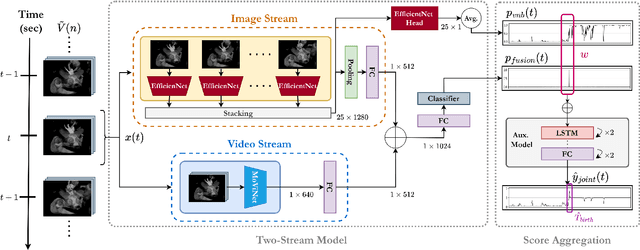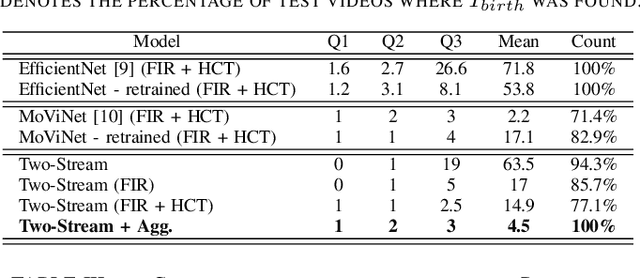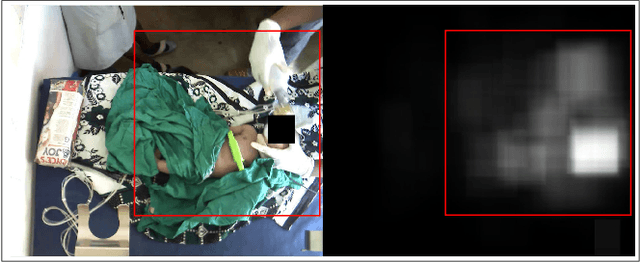Øyvind Meinich-Bache
Two-Stream Thermal Imaging Fusion for Enhanced Time of Birth Detection in Neonatal Care
Mar 05, 2025



Abstract:Around 10% of newborns require some help to initiate breathing, and 5\% need ventilation assistance. Accurate Time of Birth (ToB) documentation is essential for optimizing neonatal care, as timely interventions are vital for proper resuscitation. However, current clinical methods for recording ToB often rely on manual processes, which can be prone to inaccuracies. In this study, we present a novel two-stream fusion system that combines the power of image and video analysis to accurately detect the ToB from thermal recordings in the delivery room and operating theater. By integrating static and dynamic streams, our approach captures richer birth-related spatiotemporal features, leading to more robust and precise ToB estimation. We demonstrate that this synergy between data modalities enhances performance over single-stream approaches. Our system achieves 95.7% precision and 84.8% recall in detecting birth within short video clips. Additionally, with the help of a score aggregation module, it successfully identifies ToB in 100% of test cases, with a median absolute error of 2 seconds and an absolute mean deviation of 4.5 seconds compared to manual annotations.
AI-Based Thermal Video Analysis in Privacy-Preserving Healthcare: A Case Study on Detecting Time of Birth
Feb 05, 2025Abstract:Approximately 10% of newborns need some assistance to start breathing and 5\% proper ventilation. It is crucial that interventions are initiated as soon as possible after birth. Accurate documentation of Time of Birth (ToB) is thereby essential for documenting and improving newborn resuscitation performance. However, current clinical practices rely on manual recording of ToB, typically with minute precision. In this study, we present an AI-driven, video-based system for automated ToB detection using thermal imaging, designed to preserve the privacy of healthcare providers and mothers by avoiding the use of identifiable visual data. Our approach achieves 91.4% precision and 97.4% recall in detecting ToB within thermal video clips during performance evaluation. Additionally, our system successfully identifies ToB in 96% of test cases with an absolute median deviation of 1 second compared to manual annotations. This method offers a reliable solution for improving ToB documentation and enhancing newborn resuscitation outcomes.
Advancing Newborn Care: Precise Birth Time Detection Using AI-Driven Thermal Imaging with Adaptive Normalization
Oct 14, 2024Abstract:Around 5-10\% of newborns need assistance to start breathing. Currently, there is a lack of evidence-based research, objective data collection, and opportunities for learning from real newborn resuscitation emergency events. Generating and evaluating automated newborn resuscitation algorithm activity timelines relative to the Time of Birth (ToB) offers a promising opportunity to enhance newborn care practices. Given the importance of prompt resuscitation interventions within the "golden minute" after birth, having an accurate ToB with second precision is essential for effective subsequent analysis of newborn resuscitation episodes. Instead, ToB is generally registered manually, often with minute precision, making the process inefficient and susceptible to error and imprecision. In this work, we explore the fusion of Artificial Intelligence (AI) and thermal imaging to develop the first AI-driven ToB detector. The use of temperature information offers a promising alternative to detect the newborn while respecting the privacy of healthcare providers and mothers. However, the frequent inconsistencies in thermal measurements, especially in a multi-camera setup, make normalization strategies critical. Our methodology involves a three-step process: first, we propose an adaptive normalization method based on Gaussian mixture models (GMM) to mitigate issues related to temperature variations; second, we implement and deploy an AI model to detect the presence of the newborn within the thermal video frames; and third, we evaluate and post-process the model's predictions to estimate the ToB. A precision of 88.1\% and a recall of 89.3\% are reported in the detection of the newborn within thermal frames during performance evaluation. Our approach achieves an absolute median deviation of 2.7 seconds in estimating the ToB relative to the manual annotations.
Object Detection During Newborn Resuscitation Activities
Mar 14, 2023Abstract:Birth asphyxia is a major newborn mortality problem in low-resource countries. International guideline provides treatment recommendations; however, the importance and effect of the different treatments are not fully explored. The available data is collected in Tanzania, during newborn resuscitation, for analysis of the resuscitation activities and the response of the newborn. An important step in the analysis is to create activity timelines of the episodes, where activities include ventilation, suction, stimulation etc. Methods: The available recordings are noisy real-world videos with large variations. We propose a two-step process in order to detect activities possibly overlapping in time. The first step is to detect and track the relevant objects, like bag-mask resuscitator, heart rate sensors etc., and the second step is to use this information to recognize the resuscitation activities. The topic of this paper is the first step, and the object detection and tracking are based on convolutional neural networks followed by post processing. Results: The performance of the object detection during activities were 96.97 % (ventilations), 100 % (attaching/removing heart rate sensor) and 75 % (suction) on a test set of 20 videos. The system also estimate the number of health care providers present with a performance of 71.16 %. Conclusion: The proposed object detection and tracking system provides promising results in noisy newborn resuscitation videos. Significance: This is the first step in a thorough analysis of newborn resuscitation episodes, which could provide important insight about the importance and effect of different newborn resuscitation activities
* 8 pages
Activity Recognition From Newborn Resuscitation Videos
Mar 14, 2023



Abstract:Objective: Birth asphyxia is one of the leading causes of neonatal deaths. A key for survival is performing immediate and continuous quality newborn resuscitation. A dataset of recorded signals during newborn resuscitation, including videos, has been collected in Haydom, Tanzania, and the aim is to analyze the treatment and its effect on the newborn outcome. An important step is to generate timelines of relevant resuscitation activities, including ventilation, stimulation, suction, etc., during the resuscitation episodes. Methods: We propose a two-step deep neural network system, ORAA-net, utilizing low-quality video recordings of resuscitation episodes to do activity recognition during newborn resuscitation. The first step is to detect and track relevant objects using Convolutional Neural Networks (CNN) and post-processing, and the second step is to analyze the proposed activity regions from step 1 to do activity recognition using 3D CNNs. Results: The system recognized the activities newborn uncovered, stimulation, ventilation and suction with a mean precision of 77.67 %, a mean recall of 77,64 %, and a mean accuracy of 92.40 %. Moreover, the accuracy of the estimated number of Health Care Providers (HCPs) present during the resuscitation episodes was 68.32 %. Conclusion: The results indicate that the proposed CNN-based two-step ORAAnet could be used for object detection and activity recognition in noisy low-quality newborn resuscitation videos. Significance: A thorough analysis of the effect the different resuscitation activities have on the newborn outcome could potentially allow us to optimize treatment guidelines, training, debriefing, and local quality improvement in newborn resuscitation.
* 10 pages
 Add to Chrome
Add to Chrome Add to Firefox
Add to Firefox Add to Edge
Add to Edge